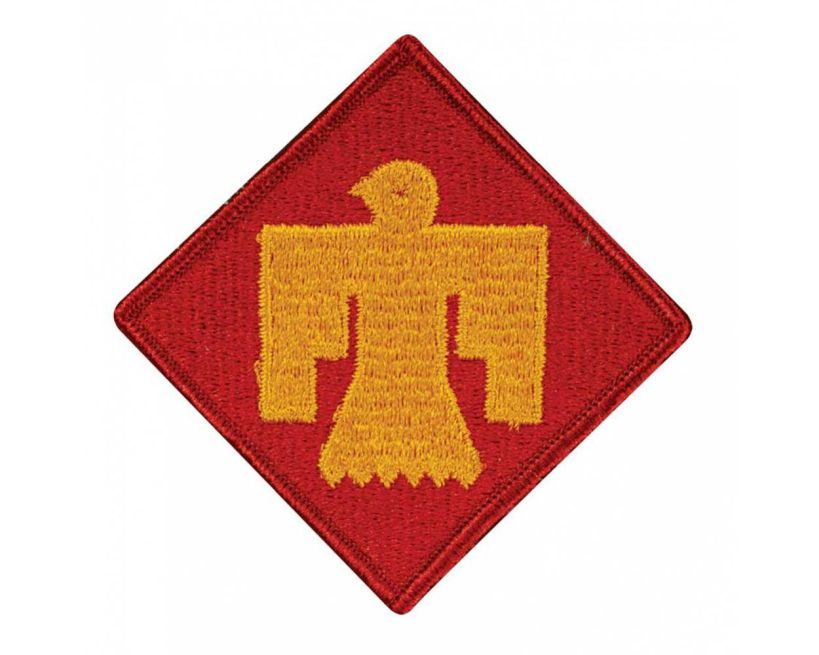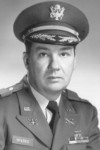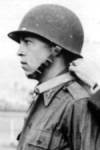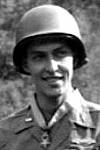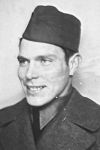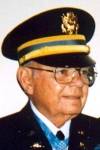Execution of SS guards at KZ Dachau, April 29th, 1945
On April 29th, 1945, the Dachau concentration camp (KZ Dachau) was liberated by units of the US Seventh Army. Units of the 42nd "Rainbow" Infantry Division and 45th "Thunderbird" Infantry Division were involved in the liberation of the camp but it remains uncertain which unit reached the camp first and liberated it. It is not only the matter of which unit liberated KZ Dachau that remained controversial; during and immediately after the liberation, an unknown number of captured guards were executed or lynched by liberated prisoners and US infantrymen, without trial. The exact reason for this and the number of those killed remain unclear.
A report by the Seventh Army, written by Lieutenant Colonel Walter J. Fellenz, mentions a total of 17 guards killed. A much higher total was reported by Colonel Howard A. Buechner, the chief medical officer of the 45th Infantry Division, who was at the camp during and after the liberation. He says that a total number of 520 Waffen SS soldiers were killed: 30 during the fighting in and around the camp, 122 were executed on the spot and 346 were lined up against a wall and executed. On top of this number, he claims that 40 guards were shot or beaten to death by liberated prisoners. Colonel Buechner described this in his book titled "The Hour of the Avenger". His statements and the number of guards killed seems much exaggerated. In his book "Deliverance Day", Michael Selzer wrote that US soldiers lined up 122 Waffen SS soldiers, who had already surrendered, against a wall and proceeded to execute them. Yet another version originates from Lieutenant Colonel Felix Sparks, the commanding officer of the 45th Infantry Division who was personally involved in the liberation of the camp. He does not deny that his men executed captured guards, but says that upon hearing these shots he hurried towards them and prevented further executions. A picture of Sparks with his left hand raised, gesturing to stop while he fired a revolver in the air seems to confirm this. The authenticity of this picture, however, is difficult to ascertain. In the book "1945: The Year of Liberation" by the US Holocaust Museum, Sparks’ version of events was used.
Presumably, the exact number of SS guards killed during the liberation of KZ Dachau by US troops will always remain unclear. Because of the chaos during the liberation and the enormous euphoria afterwards, liberated prisoners have never given a uniform description of the events. The fact that the accounts of US eye witnesses differ is apparent in the difference between the 560 victims that Colonel Brueckner mentions and the 30 to 50 according to Lieutenant Colonel Sparks. The eye witness account of a German survivor of the massacre, Oberscharführer Hans Linberger, does not shed much light on the exact amount of victims. One thing that remains sure, however, is that a war crime was committed by US liberators of the Dachau concentration camp. There is ample evidence which proves that guards were killed, a fact that never was denied by the American soldiers that were involved. However, it was certainly never proved that 560 guards were murdered in cold blood. Colonel Brueckner’s account contains some contradictions, just like other accounts in which a high death toll was mentioned. The burden of proof lies with those who state these high numbers. Until evidence surfaces of the high number of deaths, one can assume that US soldiers massacred dozens of captured guards in liberated KZ Dachau. As the exact facts are hard to determine, it is better to ask ourselves why the liberation of Dachau escalated into a blood bath.
It is important to realize that the 45th Infantry Division – which was more involved in the war crimes than the 42nd Infantry Division – had been in action for more than 500 consecutive days before they liberated Dachau. The division, which fought in Sicily, Anzio, Salerno, Southern France and in Germany, had a loss rate of 75% casualties and many soldiers had lost good friends. We can assume that the general opinion of the Germans was not positive. Also, since the fighting in the Ardennes and the massacres committed by advancing SS troops in the early days of their offensive, it was standard practice for some US Infantry Divisions to simply kill any SS men that were captured. What the GI’s encountered in KZ Dachau was, however, on a whole new level of magnitude and it drove them to behave in extreme ways. The first thing the liberators encountered was the death train with the bodily remains of 2,310 dead prisoners from the Buchenwald concentration camp. The eye witness accounts of soldiers that were present, speak for themselves. In a letter from May 6th, 1945, Colonel Walter J. Fellenz of the 42nd Infantry Division described the impression of the liberated camp and the emaciated bodies in the open wagons of the train:
"It was like approaching a rail siding in any small-size Western town where the appearance of thirty or forty box cars on a single track, lonely and desolate, is not a sight uncommon. As I neared the cars, however, I saw death and destruction of human lives at its height. Each of the thirty to forty cars contained the skin and bones of men and women, thousands of them, half-clothed in rags - dead. Upon closer inspection of the bodies, I found many contained bullet holes. I was later informed by inmates that the SS required the prisoners to lie flat in the cars."
Lieutenant Colonel Felix Sparks described what he saw during the liberation of the camp:
"The first evidence of the horror to come was a string of about forty railway cars on a siding near the camp entrance, Each car was loaded with emaciated human corpses, both men and women. […]
The scene near the entrance to the confinement area numbed my senses. Dante's Inferno seemed pale compared to the real hell of Dachau. A row of small cement structures near the prison entrance contained a coal-fired crematorium, a gas chamber, and rooms piled high with naked and emaciated human corpses. As I turned to look over the prison yard with unbelieving eyes, I saw a large number of dead inmates lying where they had fallen in the last few hours or days before our arrival. Since all the many bodies were in various stages of decomposition, the stench of death was overpowering."
What the liberators of Dachau saw surmounted all the experiences that they had had during the many months of war. They had seen comrades die and they had gotten used to the sight of many dead, but the huge amount of emaciated dead bodies in the train wagons and in the camp itself, piled high to the ceiling of the crematoria, was something new to them. Coupled with the smell of hundreds of dead bodies in various states of decomposition and with all kinds of injuries and mutilations, this was beyond the imagination and comprehension. Every veteran involved in the liberation of a concentration camp reports the same after the war: the atrocities and the scale of human suffering encountered in these camps were beyond their comprehension. The sight of large numbers of dead bodies frequently summoned the worst in the human psyche and many times the soldiers must have wondered if martial law would apply to the people responsible for these horrendous crimes. In short: it is not inconceivable that the mere sight of the many atrocities led to frenzied violence.
The fact that several camp guards were killed by the Americans during and after the liberation of the Dachau concentration camp does not seem hard to grasp but does not condone this deed. The execution of soldiers that have surrendered is an infringement of the Third Geneva Convention that regulates the treatment of POW’s. These guards could have been charged with war crimes after having been captured. Subsequently, it would have turned out that most of these men had only been appointed as guards very recently. The real perpetrators, among whom Camp Commander Martin Weiss, had fled prior to the liberation of the camp. Most of the guards that were killed in Dachau were not responsible for what was encountered on the terrain of the camp. Incidentally, the 45th Infantry Division committed additional war crimes during the Second World War. In Sicily, on July,14th,1943, in what came to be known as the Biscari massacre, troops from this division murdered 73, mostly Italian, POWs on two occasions. With their history of conducting war crimes, the chances of this unit transgressing the laws of war were greater.
The fact that liberated prisoners were involved in similar crimes is easier to comprehend. They had survived years of humiliation and abuse by their Nazi tormentors. When the camp was liberated it only seems natural that they wanted to take revenge. Countless eye witness accounts testify that guards were attacked by inmates. Also, there is at least one picture in which it seems that two prisoners intended to attack a former guard. The guards were beaten with clubs, shovels, stones and bare fists and it appears that some guards who had changed their uniforms for camp clothing were lynched on the spot along with former Kapos (fellow inmates who collaborated with the SS). American army rabbi Eli Bohnen describes the following incident:
"I still see the emaciated figure of a prisoner in front of me, how he urinated on the face of one of the guards, who lay frozen."
His colleague Max Eichhorn gives a more gruelling account:
"We stood aside and watched while these guards were beaten to death, beaten so badly that their bodies were ripped open and innards protruded. We watched with less feeling than if a dog were being beaten. In truth, it might be said that we were completely without feeling. Deep anger and hate had temporaliy numbed our emotions."
After the war no US soldiers were prosecuted for the war crimes committed at Dachau. The affair was swept under the carpet by General George S. Patton, much in the same way he had tried to do with the war crimes in Sicily in 1943. Certainly, this was not a wise decision, for it contributed to the large controversy around this subject. Furthermore, people with political aims use this affair to cast doubt on American motives and morality and use this to illustrate their revisionist views: "Weren’t the Americans really just as bad as the Nazis?"
When we answer these questions for ourselves it is important to know that the Nazis in KZ Dachau, from 1933 until 1945, were responsible for the deaths of 31,591 prisoners. The true figure is in all probability much higher. The medical experiments, the frightful punishments and the inhumane living conditions made a true hell out of KZ Dachau. When we look at this American war crime from this perspective we can only conclude that the Nazis committed the real crime at Dachau. Executing the guards was in itself a brutal war crime but is incomparable to the wholesale atrocities committed in KZ Dachau from 1933 until 1945.
Definitielijst
- concentration camp
- Closed camp where people are being held captive that are considered to be anti- social, enemies of the state, criminal or unwanted individuals. These groups mostly do not get a fair trial or are condemned to doing time in a camp.
- Dachau
- City in the German state of Bavaria where the Nazis established their first concentration camp.
- Division
- Military unit, usually consisting of one upto four regiments and usually making up a corps. In theory a division consists of 10,000 to 20,000 men.
- Holocaust
- Term for the destruction of European Jewry by the Nazis. Holokauston is the Greek term for a completely burnt sacrifice.
- Infantry
- Foot soldiers of a given army.
- martial law
- Military government, involving the suspension of ordinary law .
- Nazi
- Abbreviation of a national socialist.
- offensive
- Attack on a smaller or larger scale.
- POW
- Prisoner of War.
- war crimes
- Crimes committed in wartime. Often concerning crimes committed by soldiers against civilians.
Images
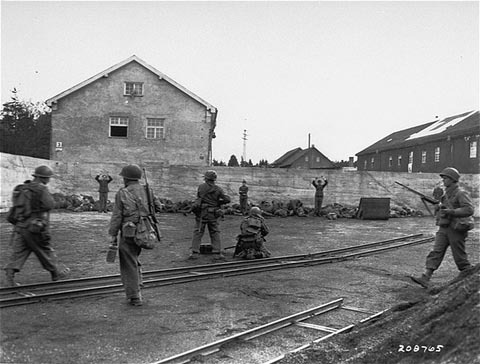 SS-men are set against the wall and a part of them are subsequently shot. Source: Dachau Scrapbook.
SS-men are set against the wall and a part of them are subsequently shot. Source: Dachau Scrapbook. The photo on which Sparks could possibly be seen while he tries to stop the executions. Source: Dachau Scrapbook.
The photo on which Sparks could possibly be seen while he tries to stop the executions. Source: Dachau Scrapbook. Prisoners torturing a camp guard. Source: Dachau Scrapbook.
Prisoners torturing a camp guard. Source: Dachau Scrapbook.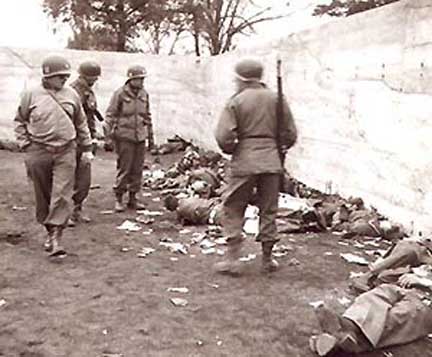 American soldiers watch the dead bodies of 11 SS-men. Source: Dachau Scrapbook.
American soldiers watch the dead bodies of 11 SS-men. Source: Dachau Scrapbook.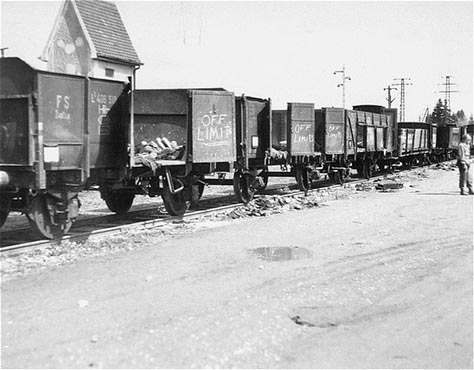 The Dachau Death Train. Source: Dachau Scrapbook.
The Dachau Death Train. Source: Dachau Scrapbook.Information
- Article by:
- Kevin Prenger
- Translated by:
- Peter ter Haar
- Published on:
- 28-06-2014
- Last edit on:
- 02-05-2020
- Feedback?
- Send it!
Related themes
Related persons
Related books
Sources
- KNOPP, G., Hitlers moordenaars, Het Spectrum, Utrecht, 2004.
- TISSIER, T. LE, The Third Reich, After the Battle, 2005.
- MOLLO, A., '40~'45 Toen & Nu nr. 27 - Dachau, Amstelveen, Tijl Periodieken.
- Axis History Forum
- Humanitas International
- Dachau Scrapbookpages
- Mail Tribune

